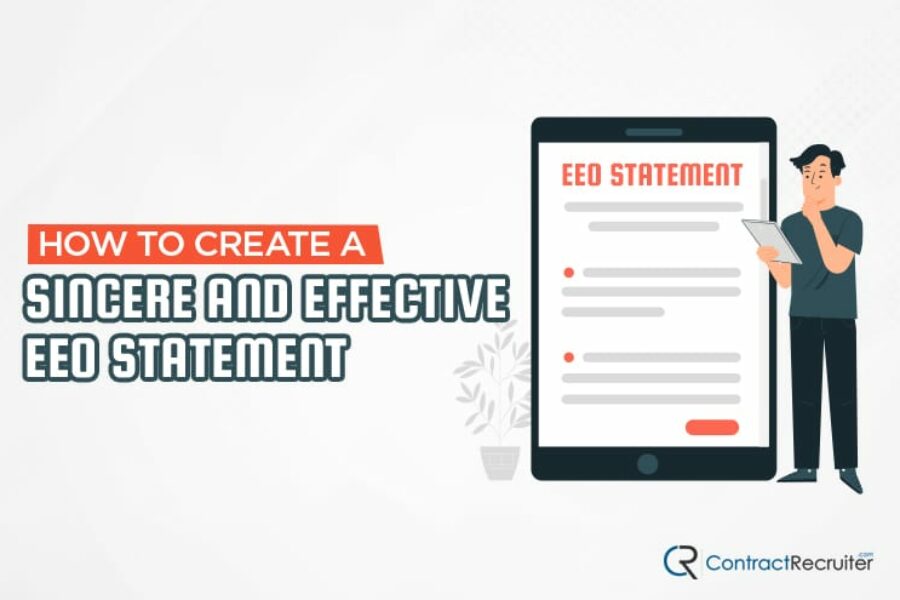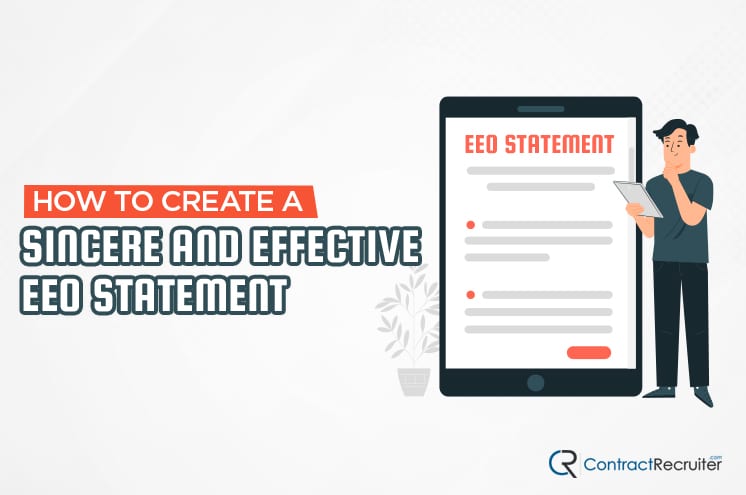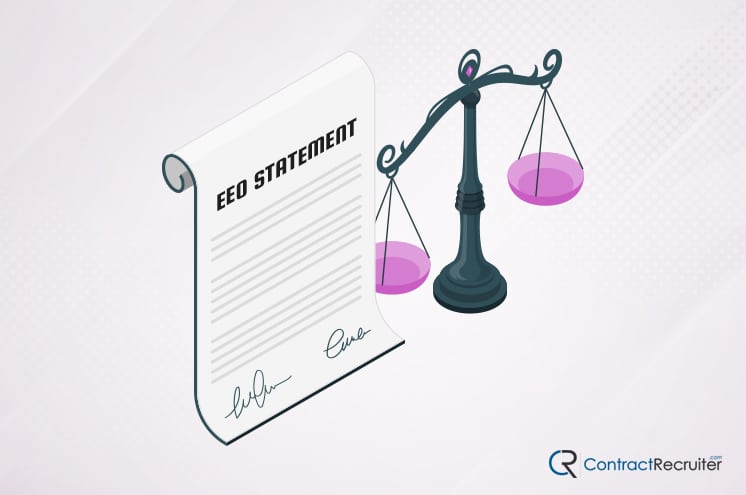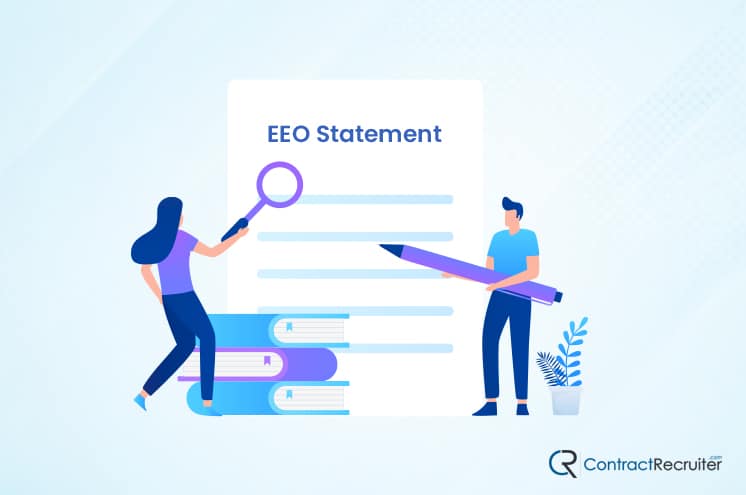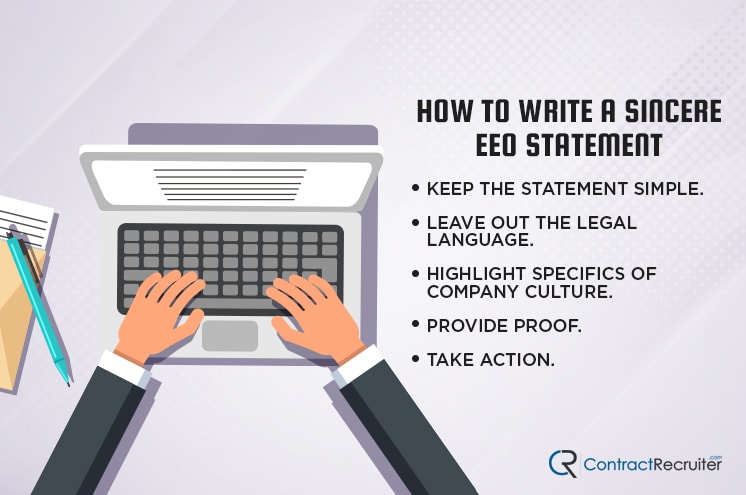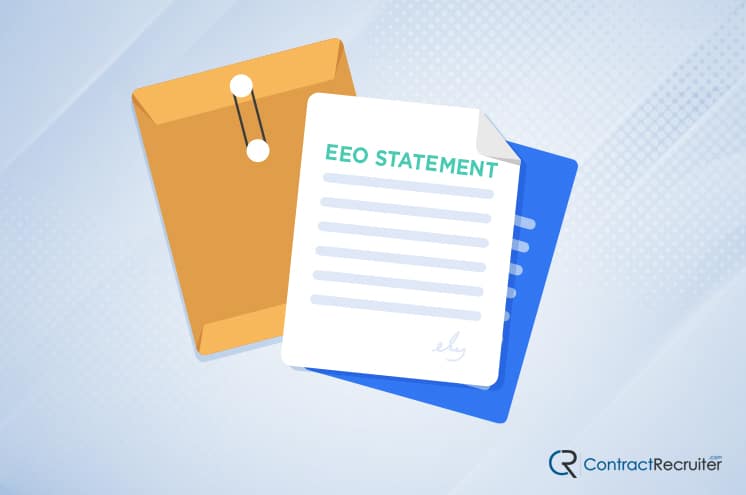Some view the EEO statement as a checklist item to publish as a line item for doing business in modern society. For others, it’s a statement of purpose and a reflection of intention. It’s no wonder that it’s contentious and often falls short of the mark. How can you write one that reflects sincerity and truly works for your business?
What Is an EEO Statement, Anyway?
An EEO statement is a statement made by an Equal Opportunity Employer. It’s meant to give a tangible voice and commitment to equality and diversity in the workplace. Usually, it’s a simple paragraph, added to other forms of paperwork such as job applications, and is often published elsewhere.
The EEO statement is typically short, but a company may have a more extensive and in-depth EEO policy published elsewhere and available for reading. Here’s a sample of an EEO statement from BetterTeam:
“[Company Name] is an equal opportunity employer committed to diversity and inclusion in the workplace. We prohibit discrimination and harassment of any kind based on race, color, sex, religion, sexual orientation, national origin, disability, genetic information, pregnancy, or any other protected characteristic as outlined by federal, state, or local laws.
This policy applies to all employment practices within our organization, including hiring, recruiting, promotion, termination, layoff, recall, leave of absence, compensation, benefits, training, and apprenticeship. [Company Name] makes hiring decisions based solely on qualifications, merit, and business needs at the time. For more information, read through our EEO Policy {Add Link}.”
As you can see, the statement doesn’t need to be complex, but it’s an essential part of a company’s commitment to equality and diversity.
Is an EEO Statement Required?
Why would a company create and publish an EEO statement if they aren’t truly dedicated to equality? The truth is, it’s complicated, as with many governmental regulations.
Federal laws regulate company behavior and make discriminating against individuals or groups of people based on particular protected characteristics illegal. Companies can be sued for discrimination, including discrimination in the hiring process. However, there’s one caveat: the laws only apply to companies with 20 or more employees, companies that have federal government contracts, or governmental agencies themselves.
“Unless you are a federal contractor, you are not required to have an EEO statement in your job postings. […] Employers with federal contracts of $10,000 or more are, however, required to provide notice in job advertisements that qualified applicants will receive consideration without regard to their race, color, religion, sex, sexual orientation, gender identity, and national origin. If the federal contract is $15,000 or more, the notice must also mention disability. If the federal contract is $150,000 or more, the notice must include status as a protected veteran.” – Mineral.
You can read more about what companies and entities are covered by equal employment law enforcement here.
This means that your company generally does not need an EEO statement unless it is a federal contractor. You are subject to discrimination laws if you’re above a specific size, but you don’t need to have the statement present in every job posting.
Of course, even if the EEO statement isn’t required, it’s often a good idea to create and include one to show your company’s dedication to equal treatment of all people.
Why Does Sincerity Matter?
One of the biggest shortcomings of the EEO statement is how frequently it ends up meaningless. Far too many companies include the EEO statement because they have to by law and don’t use it to reflect actual business practices or decisions.
For example, a series of studies into “resume whitening” (the practice of making a resume appear less diverse and more reflective of a white person). They found that, in most cases, the presence of an EEO statement had little or no effect, and company practices were often discriminatory without it. There was no real difference between companies with an EEO statement and companies without one.
In other words, it’s performative. It’s the same way that companies can take to Twitter and promote an ad campaign about recognizing women in the workplace while still paying them 20% less than men, or how they can promote LGBT rights while refusing to hire or support their LGBT workers.
Because of mandated regulations, companies publish EEO statements as a line item to comply with the law while doing nothing more than the barest minimum to remain compliant. Even then, many companies either knowingly or unknowingly violate discrimination laws and are never called on it because the people subject to discrimination either aren’t in a position to see it (an individual who isn’t hired can’t exactly see how a factor like race plays into it internally) or lack the resources to pursue a lawsuit.
The EEO statement is often a token effort with no action behind it. Companies who want to produce a sincere and effective EEO statement need to put their money where their mouth is.
How to Write a Sincere EEO Statement
The key to writing a sincere EEO statement is proof. As seen in the example above, the EEO statement itself is relatively generic and boilerplate. How do you stand out and show that you’re sincere in your statement when you’re one of a crowd of people making the same statement?
Keep the statement simple.
The actual EEO statement is often meant to be little more than 1-2 paragraphs at the bottom of your paperwork or in an online job posting. It’s not there to be a full-page document your candidates will ignore. Instead, keep your EEO simple, include the details mandated by federal labor laws (if you are subject to their inclusion), and save the details for an EEO policy page on your website.
Leave out the legal language.
Your EEO statement does not need to be drafted by a lawyer and phrased using absolute terms. In fact, in most cases, a legalese EEO statement is going to feel disingenuous and fake. People will (often correctly) get the impression that you are including it because you have to, not because you’re committed to the values you espouse in the EEO statement itself.
Instead, write your EEO statement in plain language, stating that your business is committed to diversity in hiring. Consider all angles, and feel free to go above and beyond the bare minimum list of protected classes and categories.
Highlight specifics of company culture.
Sometimes, parts of your company operations and culture highlight diversity in and of themselves. This highlight can be beneficial to showcase that you’re doing more than just including a statement; you’re putting it into practice. You’ll see that more in some examples further down.
Provide proof.
Again, an EEO statement is not meant to be an all-inclusive document proving that you’re committed to diversity. Instead, it’s a simple statement that brings attention to the fact that you’re putting effort into it.
A deeper diversity and inclusion report can be made available on your website and linked to in your EEO statement. An excellent example of this is HubSpot.
HubSpot puts a lot of effort into diversity, inclusiveness, and equal opportunity throughout its global organization. They also do two things to back up their statements.
The first is providing a diversity hub on their website, found here. This hub showcases everything from the individual stories of employees to reports about awards they’ve won for their inclusiveness to open letters they’ve published in support of minority movements.
The second is their annual diversity report, found here. Every year, HubSpot publishes a detailed report on their workforce, including formal and informal measurements of diversity and links to past reports and analyses of their progress towards greater equality.
If anyone is concerned about whether or not HubSpot is invested in diversity and inclusiveness in the workplace, this page does a pretty good job of showcasing that they’re putting real, tangible effort into it.
Take action.
Providing proof of the actions you take is crucial, but it can only be done if you’re taking action in the first place. So, what sort of actions can you take?
- Offer or require inclusivity training. There are often complaints with required training (reverse racism is common, even though it isn’t real), but typically the complaints relate more to bigots being challenged than to any real problem with training.
- Be aware of biases. In another post we wrote this week, we discuss the biases that can occur in the hiring process. Being aware of those biases is the first step towards minimizing or eliminating them. Everyone, and every process, have biases built in; no one is free from inherent, unconscious bias.
- Add structure and remove unnecessary information from the hiring process. For example, using “blind hiring” and anonymizing resumes can help remove some sources of bias that come from information like names and locations. Structure, like the use of interview scorecards, can be another way to add a more objective viewpoint and remove subjective judgment biases from decision-making.
- Ensure open lines of communication and proper channels to report issues. Equality and inclusivity are critical not just in hiring, but also in the workplace. Make sure there are lines of communication and policies in place to handle issues when they arise.
This is just a selection of the actions you can take and report on as part of your overall commitment to equal opportunity. Every company has a different starting point and will need to take different actions to handle specific biases unique to their situation.
What Does a Good EEO Statement Look Like?
To round out this post, let’s look at a few good examples of EEO statements from actual companies and why they work.
“SurveyMonkey is an equal opportunity employer. We celebrate diversity and are committed to creating an inclusive environment for all employees.” – Survey Monkey.
This is an example of a straightforward, plain-language version of an EEO statement. It mentions diversity and inclusion, avoids legalese, and does everything it needs to for a simple EEO statement. It’s light on details, but the company can make up for that elsewhere.
“At Google, we don’t just accept difference — we celebrate it, we support it, and we thrive on it for the benefit of our employees, our products, and our community. Google is proud to be an equal opportunity workplace and is an affirmative action employer.” – Google.
Google is in a controversial place. They’ve tried to take action to push for diversity and had significant pushback from white male employees. As a fast-paced tech company, they self-select for certain kinds of people, while others (notably women and minorities) tend to burn out and leave faster.
Regardless of their actual performance, their EEO statement is proactive, plain-language, and relatively effective. It will be a perfect statement if they can sort out the more tangible issues and back it up.
“Dell is an Equal Opportunity Employer and Prohibits Discrimination and Harassment of Any Kind: Dell is committed to equal employment opportunity for all employees and providing employees with a work environment free of discrimination and harassment. All employment decisions at Dell are based on business needs, job requirements, and individual qualifications, without regard to race, color, religion or belief, national, social or ethnic origin, sex (including pregnancy), age, physical, mental or sensory disability, HIV Status, sexual orientation, gender identity or expression, marital, civil union or domestic partnership status, past or present military service, family medical history or genetic information, family or parental status, or any other status protected by the laws or regulations in the locations where we operate. Dell will not tolerate discrimination or harassment based on any of these characteristics.” – Dell.
This EEO statement is an example of a less-good one. You can applaud Dell for adding a long list of categories they care about, including several that are not on the typical lists of protected categories.
The problem with this statement is that list itself. First of all, the more inclusive the company gets, the more they will need to add to the list. Secondly, if an individual has a specific concern that isn’t on the list, the specificity of the list will make them think they aren’t covered. Dell would do better with pruning the list down and making the language more casual.
So, there you have it; several examples of EEO statements and how they work (or don’t). Hopefully, this can help you produce a compelling, effective EEO statement of your own.

